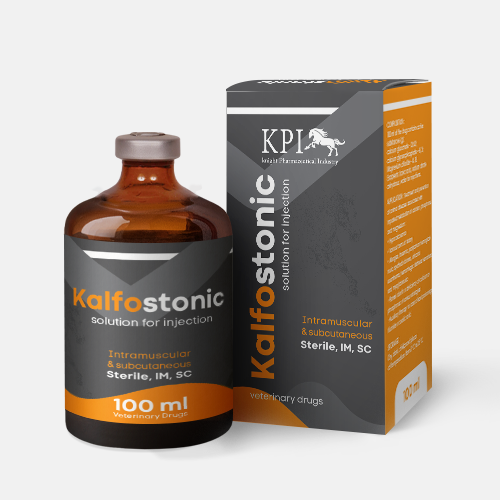
COMPOSITION:
100 ml of the drug contains active substances (g):
Calcium gluconate – 32.82;
Calcium glycerophosphate – 8,13;
Magnesium chloride – 4.18.
Excipients: up to 100 ml.
PHARMACOLOGICAL CHARACTERISTICS.
Calcium plays a pivotal role in bone strength and neuromuscular conduction by forming hydroxyapatite crystals and regulating biological membrane permeability. Its deficiency heightens nerve excitability, potentially leading to tetany, while also modulating protein colloidal condition and reducing blood vessel permeability. Moreover, calcium stimulates the cardiovascular system and adrenaline release, influencing blood coagulation.
Phosphorus, alongside calcium, contributes to bone and teeth development, forming essential components like phospholipids, phosphoproteins, nucleic acids, and coenzymes. It supports acid-base balance and carbohydrate metabolism, with adenosine triphosphate aiding in energy accumulation and transformation.
Magnesium, a vital intracellular ion, activates numerous enzymes involved in phosphate compound energy maintenance and regulates acetylcholine release and muscle excitability.
APPLICATION:
The drug is utilized to treat and prevent animal diseases related to impaired calcium, phosphorus, and magnesium metabolism, including hypocalcaemia, various forms of tetany, allergic reactions, paresis, and as auxiliary therapy in cases of lead poisoning, fluoride, or oxalic acid.
DOSAGE & ADMINISTARTION:
Administer intravenously, intramuscularly, or subcutaneously as per the provided dosage table. Re-administer at the same doses after 24 hours if necessary. Use caution, especially in animals with heart and kidney conditions. Intravenous administration should be slow to avoid arrhythmias and cardiac blockade. Avoid concurrent use with digitalis drugs to prevent cardiac function disturbances or blockade. Concurrent use of calcium and vitamin D analogues may lead to hypercalcemia.
| TYPE OF ANIMAL | DOSE OF THE DRUG (ML) | METHOD OF INJECTION |
| HORSE BW 500 KG | 80-100 | INTRAVENOUSLY, (IV) |
| CATTLE BW 500 KG | 80-100 | INTRAVENOUSLY, INTRAMUSCULARLY OR SUB- CUTANEOUSLY, (IV, IM or SC) |
| SHEEP, GOATS | 15-25 | INTRAVENOUSLY, INTRAMUSCULARLY OR SUB- CUTANEOUSLY,(IV, IM or SC) |
| PIGS | 15-25 | INTRAVENOUSLY, INTRAMUSCULARLY OR SUB- CUTANEOUSLY,(IV, IM or SC) |
| PIGLETS | 2-3 | INTRAMUSCULARLY OR SUBCUTANEOUSLY (IM or SC) |
PRECAUTIONS:
- Avoid injecting more than 50 ml of the drug at a single intramuscular or subcutaneous site.
- Use caution when administering to animals with heart and kidney diseases.
- Administer intravenous injections slowly to prevent arrhythmias and cardiac blockade.
- Intramuscular or subcutaneous injections pose a lower risk of adverse effects compared to intravenous injections.
- Avoid simultaneous use with digitalis drugs to prevent disruptions in cardiac function or blockade.
- Concomitant use of calcium and vitamin D or their analogues may result in hypercalcemia.
WITHDRAWAL:
During treatment, animal meat and milk can be safely consumed by humans.
CONTRAINDICATIONS:
Avoid in cases of hypercalcemia, acidosis, renal failure, excessive nervous excitation, ventricular fibrillation, or hypersensitivity to any component of the drug.
PACKAGING :
Available in 100 and 250 ml glass bottles.
STORAGE:
Store in a dark, child-inaccessible place at temperatures between 5°C to 25°C. Use within 28 days of opening.
FOR VETERINARY USE ONLY!
